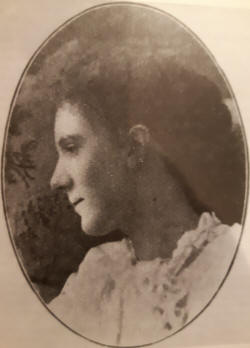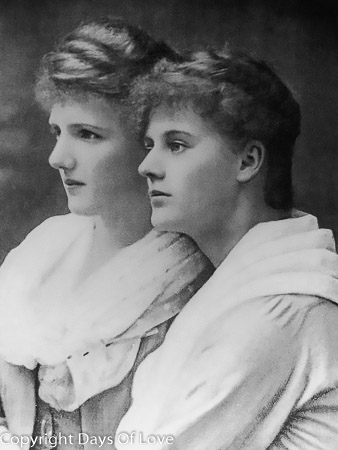

Partner Esther Roper, buried together
Queer Places:
(1900) 83 Heald Pl, Manchester M14 4AQ, UK
(1921) 14 Frognal Gardens, London NW3 6UX, UK
Lissadell House, Lissadill, Ballinfull, Co. Sligo, Irlanda
Académie Julian, Passage des Panoramas, Paris, Francia
33 Fitzroy Square, Fitzrovia, London W1T 6EU, UK
St John at Hampstead, Hampstead, Londra NW3, Regno Unito
 Eva
Selina Laura Gore-Booth (22 May 1870 – 30 June 1926) was an Irish poet[1]
and dramatist, and a committed suffragist, social worker and labour
activist. Eva Gore-Booth lived with Esther Roper
for 30 years, in Manchester and in Hampstead. Her name and picture (and those of 58 other women
and men's suffrage supporters)
are on the
plinth of the
statue of
Millicent Fawcett in
Parliament Square, London, unveiled in 2018.
Eva
Selina Laura Gore-Booth (22 May 1870 – 30 June 1926) was an Irish poet[1]
and dramatist, and a committed suffragist, social worker and labour
activist. Eva Gore-Booth lived with Esther Roper
for 30 years, in Manchester and in Hampstead. Her name and picture (and those of 58 other women
and men's suffrage supporters)
are on the
plinth of the
statue of
Millicent Fawcett in
Parliament Square, London, unveiled in 2018.
Urania was a lesbian magazine, founded in 1915, which attracted a circle of women to its publication, includeing Eva Gore-Booth and Esther Roper, amongst others. The suffragist and poet Eva Gore-Booth met her partner, Esther Roper, in Italy in 1896 when they were both in their late 20s, and they formed a permanent union around a joint commitment to working women’s rights. The journal Urania offered a critique of sexological literature in the XIX century. The jorinal was published between 1915 and 1940 by a small group of feminist men and women, including Thomas Baty/Irene Clyde, a respected legal scholar, and the feminist couple Eva Gore-Booth and Esther Roper. Urania had a circulation of approximately two hundred and was distributed by private circulation.
Eva Gore-Booth was born at Lissadell House, County Sligo, the younger sister of Constance Gore-Booth, later known as the Countess Markievicz.
Eva Selina Gore-Booth was born in County Sligo, Ireland, to Sir Henry and Lady Georgina Gore-Booth of Lissadell. She was the third of five children born to the 5th Baronet and his wife and the first of her siblings to be born at Lissadell House. She and her siblings, Josslyn Gore-Booth (1869–1944), Constance Georgine Gore-Booth (1868–1927), Mabel Gore-Booth (1874–1955), and Mordaunt Gore-Booth (1878–1958), were the third generation of Gore-Booths at Lissadell. The house was built for her paternal grandfather, Sir Robert Gore-Booth, 4th Baronet, between 1830 and 1835 and three generations of Gore-Booths resided there during Eva's childhood, including her paternal grandfather and her maternal grandmother Lady Frances Hill.

Eva and Constance had several governesses throughout their childhood, most notably Miss Noel who recorded most of what is known about Eva's early life. She learned French, German, Latin and Greek and developed a love of poetry that was instilled by her maternal grandmother. Eva was troubled by the stark contrast between her family's privileged life and the poverty outside Lissadell, particularly during the winter of the Irish Famine (1879) when starving tenants would come to the house begging for food and clothing. Esther Roper later remarked that Eva was "haunted by the suffering of the world and had a curious feeling of responsibility for its inequalities and injustices."[2]
Eva's father was a notable Arctic explorer and, during a period of absence from the estate in the 1870s, her mother, Lady Georgina, established a school of needlework for women at Lissadell. The women were trained in crochet, embroidery and darn-thread work and the sale of their wares allowed them to earn a wage of 18 shillings per week. This enterprise had a great influence on Eva and her later women's suffrage and trade union work.
In 1894, Eva joined her father on his travels around North America and the West Indies. She kept diaries and documented their travels in "Jamaica, Barbados, Cuba, Florida, New Orleans, St Louis, San Francisco, Vancouver, Toronto, Niagara, Montreal and Quebec."[3] On returning to Ireland she met the poet W.B. Yeats for the first time. The following year she traveled around Europe with her mother, sister Constance, and friend Rachel Mansfield and, while in Venice, fell ill with a respiratory condition. In 1896, while recuperating at the villa of writer George MacDonald and his wife in Bordighera, Italy, she met Esther Roper, the English woman who would become her lifelong companion.
Meeting political activist Esther Roper in Italy in 1896, where Eva was sent to recover from respiratory ailments, was a deciding factor in Eva's active involvement in women's rights of the suffrage movement.[3] The two women formed a strong attachment during the weeks spent together at the villa of writer George MacDonald and his wife in Bordighera which led to a partnership, privately and professionally, until Eva's death in June 1926.[9] How intimate her relations were with Roper is controversially discussed, however, letters and poems Eva dedicated to Esther suggest a romantic love between the two women.[10] One of those poems appears in a collection of Eva's poetic work "The Travellers, To E.G.R" which was published by Roper in 1929 in which Eva uses analogies of music and song to express how deeply she was struck by Esther's personality and charisma.[11][12]
After years of playing a lead role in the Women's Suffrage Movement and fighting for equality of women's rights in the UK as well as staying true to her literary roots, Eva and Esther relocated to London from Manchester in 1913 due to Eva's deteriorating respiratory health.[10] During World War I, Eva and Esther were actively involved in the British Peace Movement along with fellow suffragists, such as Sylvia Pankhurst and Emily Hobhouse. At the Women's International Congress which took place at the city of Hague in 1915, she jointly composed an open Christmas letter entitled "To the Women of Germany & Austria" urging to "... join hands with the women of neutral countries, and urge our rulers to stay further bloodshed ..." and appealing to a sense of sisterhood to prevent further atrocities and the war from escalating.[3]
Just weeks after the 1916 Rising, Eva traveled to Dublin accompanied by Esther and was pivotal in the efforts to reprieve the death sentence of her sister Constance Markievicz awarded for her instrumental role in the 1916 Rising, which was successfully converted to a life sentence. Her poetry composed during this period reflect the personal trauma and horror she was exposed to visiting her sister in solitary confinement.[10] She further campaigned to abolish the death sentence overall and to reform prison standards and attended the trial of Irish nationalist and fellow poet Roger Casement thus showing solidarity and support for the overturning of his death sentence.[10]
During the remaining years of her life, which was claimed by cancer on 30 June 1926, she remained devoted to her poetry, dedicated time to her artistic talents as a painter, studied the Greek language and was known as a supporter of animal rights. Eva died in her home in Hampstead, London she shared with Esther until her passing. She was buried alongside Esther Roper in St John's churchyard, Hampstead, with a quote from lesbian icon Sappho carved on their gravestone.[13]
Eva Gore-Booth's sexuality has been a topic for debate among academics, some of whom argue that she and Esther Roper were in a same sex relationship, others that the two women merely cohabited.
After being told that she was close to death in 1896 Eva took a trip to the home of George MacDonald in Bordighera, Italy, to recuperate. It was there where she met Esther Roper who was also recovering from illness. They formed a strong mutual bond and were partners in life and work from then on.[9] After the time they spent there together Eva further rejected her privileged rural life in Ireland and moved into the urban Manchester environment. There she purchased property with Esther and who became her partner in her sexual politics activism and suffrage work.[17] Although Eva and Esther lived together till Eva's death they slept in different rooms and there is no way of proving or disproving a sexual relationship or any sort of sexual encounters between them. After knowing each other for four years Eva made Esther the sole beneficiary of her estate.[18]
Both Eva and Esther worked with a team of professionals to establish and edit Urania, a sexual politics journal that was circulated between 1916 and 1940. The formation was due to the editors being connected through a feminist revolutionary group known as the Aëthnic Union which was formed in 1911.[12] Urania was a radical journal that contributed to the discussion on sexual politics of the Suffrage era. It was established to document and enhance the progress of the first wave feminist movement.[19] Its aim was to promote the elimination of the glorification of heterosexual marriage and sex and gender distinctions altogether.[20] It also became a point of reference for those worldwide who shared the editors' radical, Uranian Philosophy. 'Sex is an Accident' a term coined by Eva regarding biological gender distinction was used to sum up the Uranian philosophy.
The journal for most of its publication was privately circulated worldwide but was sent free to anyone who requested it to establish a network and register of supporters.[19] Eva was seen as the figure head and founder of this journal as it tied into her theosophical feminist beliefs. Urania was ranged from eight to sixteen pages of compositions, magazines clippings, extracts and reports about sex changes and scientific methods, lesbian women in history as well as challenging and overcoming society's gender norms.[20]
Urania monitored birth and marriage rates worldwide and celebrated when the rates fell. It also promoted the idea of same-sex love being the ideal particularly between females and it being spiritual in nature rather than physical. Throughout all this discussion Eva was noted in Urania as an inspiration and her words and her poetry was quoted in it long after her death.[20]
Eva is buried alongside Esther in Hampstead in England and her tombstone reads "Life that is Love is God" a quote from the poet Sappho whose love of women was reflected in her work.[12]
Despite the debate on her sexuality Eva Gore-Booth has been honoured for her work by the LGBTQ+ community including an award in her honour at the Dublin Gay Theatre Festival.[21] Eva has also been acknowledged by the Irish Congress of Trade Unions as LGBTQ+ and Worker's Rights role model.[22]
My published books: